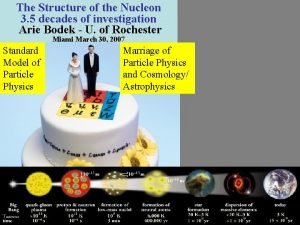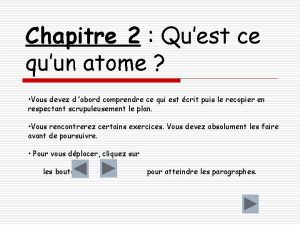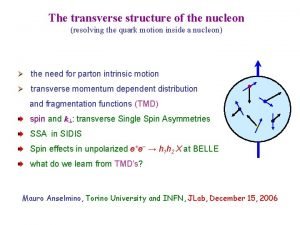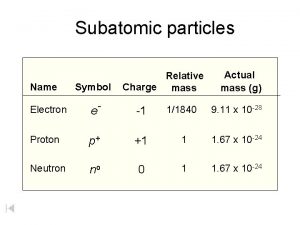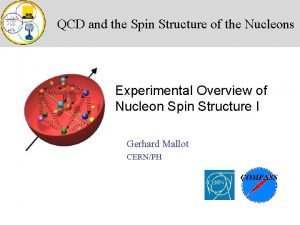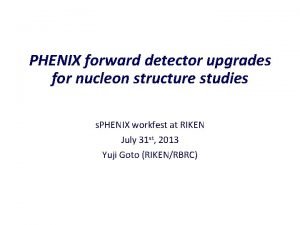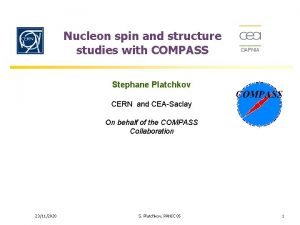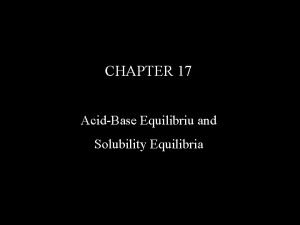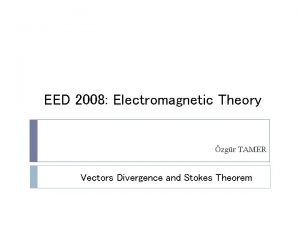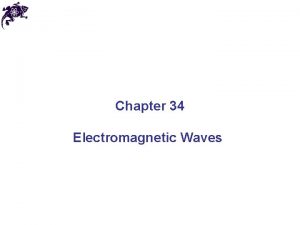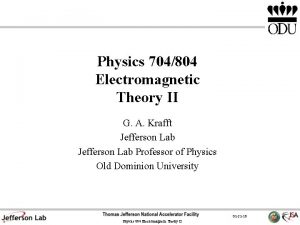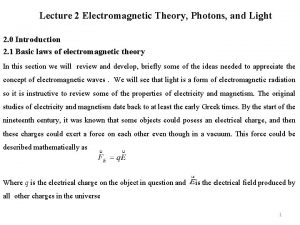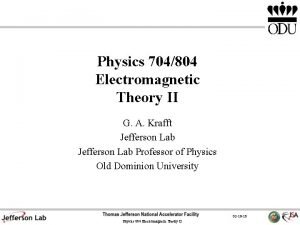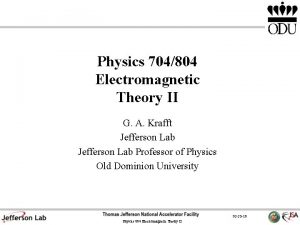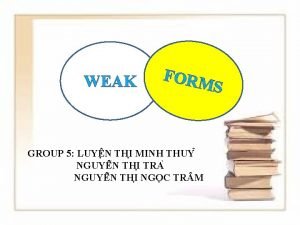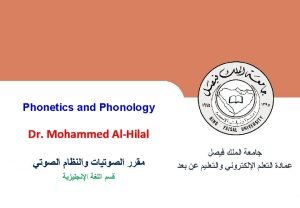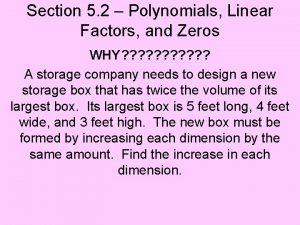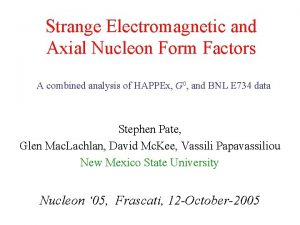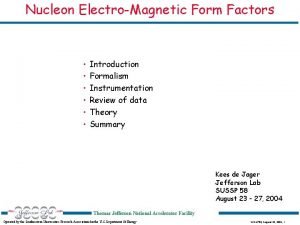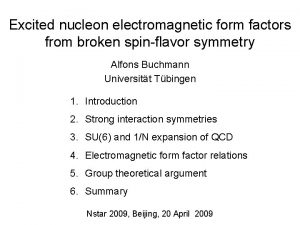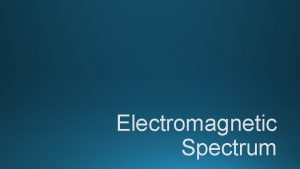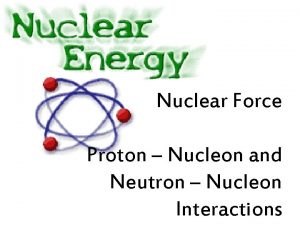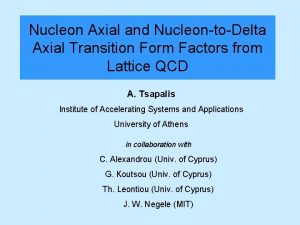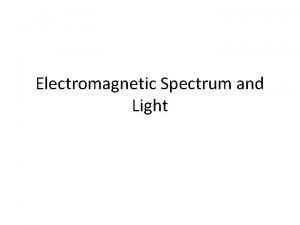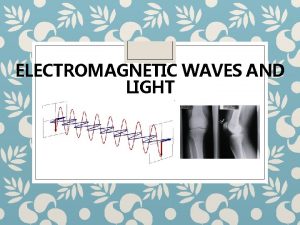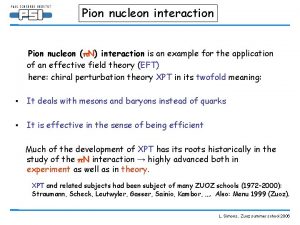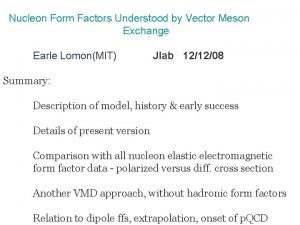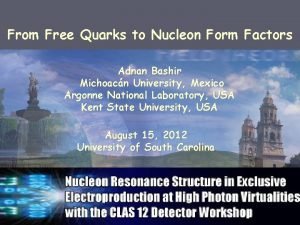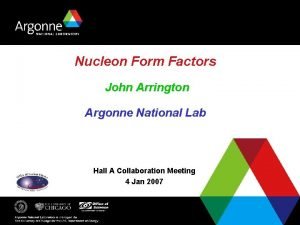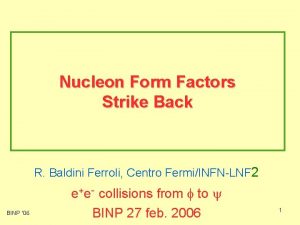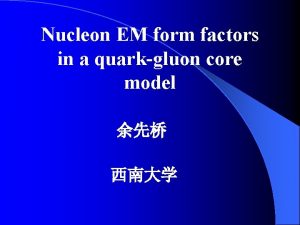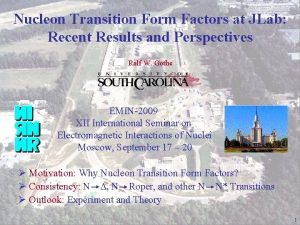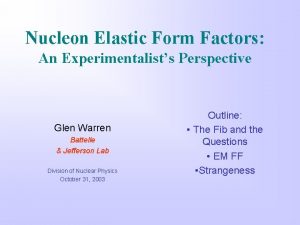Nucleon Electromagnetic and Weak Form Factors Theory Overview





























- Slides: 29

Nucleon Electromagnetic and Weak Form Factors Theory Overview Andrei Afanasev Jefferson Lab JLab Users Workshop Jefferson Lab June 20, 2005 Operated by the Southeastern Universities Research Association for the U. S. Dept. of Energy Andrei Afanasev, JLab Users Workshop, 6/2005

Elastic lepton scattering and nucleon structure How does the nucleon respond to the electromagnetic or weak probe? • Study Form Factors at high Q 2: QCD, GPDs; Helicity Flip; OAM; Ji’s sum rule; Lattice QCD • Status of nucleon form factor measurements : See review C. Hyde-Wright, K. de Jager, Annu. Rev. Nucl. Part. Sci. 54, 217 (2004) Operated by the Southeastern Universities Research Association for the U. S. Dept. of Energy Andrei Afanasev, Carl. Fest, 5/7/05

GPDs, DIS, and Elastic Form Factors Link to DIS at x =t=0 H q ( x, 0, 0) = q( x), -q (-x) ~q H ( x, 0, 0) = Dq( x), Dq (-x) Link to form factors (sum rules) ~ ~ H , E , H q , E q ( x, x , t ) q q ( x, x, t) ] = F 1 ( t ) Dirac FF ( x, x, t) ] = F 2 ( t ) Pauli FF ò dxå[H q ò dxå[E q 1 q 1 1 -1 -1 ~q x = dx H ( x , , t ) G ( t ) , dx E , A q ò ò (x, , t) GP, q ( t) Access to quark angular momentum (X. Ji’s sum rule) 1 1 1 J q = - JG = ò xdx H q ( x, x, 0) + E q ( x, x, 0) 2 2 -1 [ Operated by the Southeastern Universities Research Association for the U. S. Dept. of Energy ] Andrei Afanasev, Carl. Fest, 5/7/05

Global Analysis P. Bosted et al. PRC 51, 409 (1995) Three form factors very similar GEn zero within errors -> accurate data on GEn early goal of JLab Madey et al. ; Day et al. (polarization methods) Operated by the Southeastern Universities Research Association for the U. S. Dept. of Energy Andrei Afanasev, Carl. Fest, 5/7/05

Neutron Form Factors For Q 2 > 1 Ge. V 2 data indicate that GEn has similar Q 2 -behaviour as GEp Operated by the Southeastern Universities Research Association for the U. S. Dept. of Energy GMn follows dipole dependence Andrei Afanasev, Carl. Fest, 5/7/05

Elastic Nucleon Form Factors • Based on one-photon exchange approximation • Two techniques to measure Latter due to: Akhiezer, Rekalo; Arnold, Carlson, Gross Operated by the Southeastern Universities Research Association for the U. S. Dept. of Energy Andrei Afanasev, JLab Users Workshop, 6/2005

Do the techniques agree? SLAC/Rosenbluth ~5% difference in cross-section JLab/Polarization . . Both early SLAC and Recent JLab experiments on (super)Rosenbluth separations followed Ge/Gm~const JLab measurements using polarization transfer technique give different results (Jones’ 00, Gayou’ 02) Radiative corrections, in particular, a short-range part of 2 -photon exchange is a likely origin of the discrepancy Operated by the Southeastern Universities Research Association for the U. S. Dept. of Energy Andrei Afanasev, JLab Users Workshop, 6/2005

Q 2 dependence of Dirac vs. Pauli form factors . JLab polarization transfer data favored Earlier SLAC+recent JLab spin-unpolarized data Belitsky, Ji and Yuan suggested thet p. QCD picture Holds, but with double-log corrections: Operated by the Southeastern Universities Research Association for the U. S. Dept. of Energy Andrei Afanasev, JLab Users Workshop, 6/2005

Log-corrected scaling . Consistency with polarization data Operated by the Southeastern Universities Research Association for the U. S. Dept. of Energy Andrei Afanasev, JLab Users Workshop, 6/2005

From fitting Form Factors to fitting GPDs . . Radyushkin’ 98, Afanasev’ 98, 99, Stoler’ 02 New generation of fits: Diehl et al. , Eur. Phys. J. C 39: 1 -39, 2005, Guidal et al. , hep-ph/041025. Operated by the Southeastern Universities Research Association for the U. S. Dept. of Energy Andrei Afanasev, JLab Users Workshop, 6/2005

Matching CBM and Lattice QCD . Matevosyan, Miller, Thomas’ 05 Operated by the Southeastern Universities Research Association for the U. S. Dept. of Energy Andrei Afanasev, JLab Users Workshop, 6/2005

Electron Scattering: LO and NLO in αem Radiative Corrections: • Electron vertex correction (a) • Vacuum polarization (b) • Electron bremsstrahlung (c, d) • Two-photon exchange (e, f) • Proton vertex and VCS (g, h) • Corrections (e-h) depend on the nucleon structure • Guichon&Vanderhaeghen’ 03: Can (e-f) account for the Rosenbluth vs. polarization experimental discrepancy? Look for ~3%. . . Main issue: Corrections dependent on nucleon structure Model calculations: • Blunden, Melnitchuk, Tjon, Phys. Rev. Lett. 91: 142304, 2003 • Chen, AA, Brodsky, Carlson, Vanderhaeghen, Phys. Rev. Lett. 93: 122301, 2004 Operated by the Southeastern Universities Research Association for the U. S. Dept. of Energy Andrei Afanasev, JLab Users Workshop, 6/2005

Separating soft photon exchange. . Tsai; Maximon & Tjon We used Grammer &Yennie prescription PRD 8, 4332 (1973) (also applied in QCD calculations) Shown is the resulting (soft) QED correction to cross section NB: Corresponding effect to polarization transfer is zero ε δSoft Operated by the Southeastern Universities Research Association for the U. S. Dept. of Energy Q 2= 6 Ge. V 2 Andrei Afanasev, JLab Users Workshop, 6/2005

Two-Photon Effect for Rosenbluth Cross Sections. . Data shown are from Andivahis et al, PRD 50, 5491 (1994) Included GPD calculation of twophoton-exchange effect Qualitative agreement with data: Discrepancy likely reconciled Operated by the Southeastern Universities Research Association for the U. S. Dept. of Energy Andrei Afanasev, JLab Users Workshop, 6/2005

Updated Ge/Gm plot AA, Brodsky, Carlson, Chen, Vanderhaeghen, Phys. Rev. Lett. 93: 122301, 2004; hep-ph/0502013 Operated by the Southeastern Universities Research Association for the U. S. Dept. of Energy Andrei Afanasev, JLab Users Workshop, 6/2005

Two-Photon Effect for Rosenbluth Cross Sections . Blunden, Melnitchouk, Tjon, Phys. Rev. Lett. 91: 142304, 2003; nuclth/0506039 Operated by the Southeastern Universities Research Association for the U. S. Dept. of Energy Andrei Afanasev, JLab Users Workshop, 6/2005

Polarization transfer from GPDs. Also corrected by two-photon exchange, but with little impact on Gep/Gmp extracted ratio Operated by the Southeastern Universities Research Association for the U. S. Dept. of Energy Andrei Afanasev, JLab Users Workshop, 6/2005

Charge asymmetry. Cross sections of electron-proton scattering and positron-proton scattering are equal in one-photon exchange approximation. Different for two- or more photon exchange To be measured in JLab Experiment 04 -116, Spokepersons W. Brooks et al. Operated by the Southeastern Universities Research Association for the U. S. Dept. of Energy Andrei Afanasev, JLab Users Workshop, 6/2005

. Backward-angle double-logarithm resummation of multi-photon exchange Electron-muon scattering at backward angles; calculations by Gorshkov, Gribov, Lipatov, Frolov, Sov. J. Nucl. Phys. 6, 95 (1968): . Double-logarithmic contributions coming from . . Hard-photon exchange with highly-virtual spinor states Resummation via recurrence relations (Bethe-Salpeter ladder resummation gives an equivalent result) For opposite-charge particles, Rad. Correction omitted in Mo-Tsai approach is negative and log-enhanced at backward scattering angles (small ε); zero at forward angles => Positive correction to Rosenbluth slope Operated by the Southeastern Universities Research Association for the U. S. Dept. of Energy Andrei Afanasev, JLab Users Workshop, 6/2005

(Previously Neglected) Effect from Hard Brem Additional work in progress: Role of spin-dependent terms in conventional (hard) bremsstrahlung (1 -2% effect) Radiative leptonic tensor in full form AA et al, PLB 514, 269 (2001) Size of hard brem correction Operated by the Southeastern Universities Research Association for the U. S. Dept. of Energy Andrei Afanasev, JLab Users Workshop, 6/2005

2γ-exchange Correction to Parity-Violating Electron Scattering γ Electromagnetic . γ x Z 0 Neutral Weak New parity violating terms due to (2 gamma)x(Z 0) interference should be added: Operated by the Southeastern Universities Research Association for the U. S. Dept. of Energy Andrei Afanasev, JLab Users Workshop, 6/2005

GPD Calculation of 2γ×Z-interference . Can be used at higher Q 2, but points at a problem of additional systematic corrections for parity-violating electron scattering. The effect evaluated in GPD formalism is the largest for backward angles: AA & C. Carlson, PRL 94, 212301 (2005): measurements of strange-quark content of the nucleon are affected, Δs may shift by ~10% Operated by the Southeastern Universities Research Association for the U. S. Dept. of Energy Andrei Afanasev, JLab Users Workshop, 6/2005

Two-photon exchange for electron-proton scattering. . Quark-level short-range contributions are substantial (3 -4%) ; correspond to J=0 fixed pole (Brodsky-Close-Gunion, PRD 5, 1384 (1972)). Structure-dependent radiative corrections calculated using Generalized Parton Distributions bring into agreement the results of polarization transfer and Rosenbluth techniques for Gep measurements Collinear photon exchange dominance for beam asymmetry Experimental tests of multi-photon exchange. Comparison between electron and positron elastic scattering. Measurement of nonlinearity of Rosenbluth plot. Search for deviation of angular dependence 2 of polarization and/or asymmetries from Born behavior at fixed Q. Elastic single-spin asymmetry or induced polarization. All above tests are now approved JLab experiments => Through active theoretical support emerged=> JLab program of double-virtual VCS studies with two spacelike photons Operated by the Southeastern Universities Research Association for the U. S. Dept. of Energy Andrei Afanasev, JLab Users Workshop, 6/2005

Weak processes . . . Measurements of fundamental constants of EW interactions Learning the structure of nucleon Weak decays Neutrino scattering Weak capture Operated by the Southeastern Universities Research Association for the U. S. Dept. of Energy Andrei Afanasev, JLab Users Workshop, 6/2005

Neutrino Scattering. Experiments with accelerator neutrinos: . Long history: Fanorakis et al PRD 21, 62 (1980); Ahrens et al. , PRD 35, 78 . . (1987); PLB 202, 284 (1988); Barish et al. , PRD 16, 3103 (1977), Miller et al. , PRD D 26, 537 (1982); Mann et al. , PRL 31, 844 (1973); Baker et al. , PRD 23, 2499; Kitagaki et al. PRD 28, 436 (1983); D 42, 1331 (1990). Anticipated experiments with neutrino beams at Fermilab (see hepex/0405002 by Minerva Collab. ) Need to study JLAB opportunities on weak electron capture Operated by the Southeastern Universities Research Association for the U. S. Dept. of Energy Andrei Afanasev, JLab Users Workshop, 6/2005

Probe neutral weak current of a nucleon . . Measurements of νp→νp are free of rad. corrections uncertainties for GA(Q 2) relevant to ep→ep (Musolf & Holstein) Available measurements from BNL Ahrens et al’ 87 Operated by the Southeastern Universities Research Association for the U. S. Dept. of Energy Andrei Afanasev, JLab Users Workshop, 6/2005

Electroproduction of pions . Electroproduction of pions near threshold can be used to obtain GA through measurement of Kroll-Ruderman in E 0+ amplitudes. See review by Bernard, Elouadrhiri, Meissner, J. Phys. G: Nucl. Part. Phys. 28 (2002) R 1 Operated by the Southeastern Universities Research Association for the U. S. Dept. of Energy Andrei Afanasev, JLab Users Workshop, 6/2005

Weak transition form factors . . . Nucleon beta-decay: CKM matrix Vud Kl 3 decays (timelike regime) are a source of information of a) Vsu CKM matrix element b) low-energy QCD Space-like regime is inaccessible in decays, but can be probed in either neutrino scattering (e. g. , at Fermilab) or weak capture at JLab AA, Buck, PRD’ 97 Operated by the Southeastern Universities Research Association for the U. S. Dept. of Energy Andrei Afanasev, JLab Users Workshop, 6/2005

Summary . . . Substantial progress in theory of form factors for the recent years, stimulated by JLab data on electromagnetic form factors. GPD and Lattice QCD in particular Both electromagnetic and weak form factors need to be included JLab potential on weak form factor measurements beyond PVscattering needs to be explored Operated by the Southeastern Universities Research Association for the U. S. Dept. of Energy Andrei Afanasev, JLab Users Workshop, 6/2005
 Nucleon
Nucleon M atome = a x m nucleon
M atome = a x m nucleon Nucleon
Nucleon Subatomic particles symbols
Subatomic particles symbols Nucleon
Nucleon Nucleon
Nucleon Nucleon
Nucleon Weak acid and weak base reaction
Weak acid and weak base reaction Strong acods
Strong acods Strong acid-strong base titration indicator
Strong acid-strong base titration indicator Weak and strong form of can
Weak and strong form of can Divergence in electromagnetic theory
Divergence in electromagnetic theory Energy density of electromagnetic waves
Energy density of electromagnetic waves Electromagnetic theory
Electromagnetic theory Electromagnetic theory
Electromagnetic theory Electromagnetic theory
Electromagnetic theory Electromagnetic theory
Electromagnetic theory Abiotic factor
Abiotic factor Abiotic factors and biotic factors
Abiotic factors and biotic factors Abiotic vs biotic factors
Abiotic vs biotic factors Prime factors of 49
Prime factors of 49 Factors of 7
Factors of 7 Factors of 42
Factors of 42 Weak and strong forms exercises
Weak and strong forms exercises Progressive assimilation examples
Progressive assimilation examples Present continuous negative and interrogative
Present continuous negative and interrogative Site vs location
Site vs location Biotic and abiotic factors definition
Biotic and abiotic factors definition Site vs. situation
Site vs. situation 5-2 polynomials linear factors and zeros form g
5-2 polynomials linear factors and zeros form g
